
B.B. King by Justin Block, licensed under (CC BY-SA 2.0)
I don’t know about you, but when I see those books and courses titled something like ‘Learn 256 blues licks’ or ‘Play 99 country rock lead licks’ or something, I get a bit annoyed. Not because those books and courses aren’t good, I’m sure they are, but because who really needs to learn a 100 licks. I mean really, c’mon. How many of those licks do most players actually use?
During the first 5 years or so of my playing I wasted so much time learning licks I would never use; it annoys the hell out of me looking back on it. One thing I used to do was subscribe to Total Guitar magazine here in the UK. It was a decent magazine, and some of the articles opened my eyes up to different styles and techniques which was cool.
They had various features including teaching rock and blues licks in different styles and I used to sit around learning them, but before I had mastered one I would move on to the next one, and so on. After doing it for a bit I had multiple licks I didn’t really know how to use and apply in the real world while jamming with a band or a backing track.
Big mistake.
Most guitarists don’t really know how to use guitar licks. If you learn a lick, you absolutely must jam the hell out of it until you can play that lick in a massive amount of ways.
You only really know a lick when you can play over a bunch of different backing tracks, at different tempos and be able to play it with lots of little variations. You want to be able bend the hell out of it, play it upside down, play it in reverse, funk up its rhythm, squeeze the life out of it, and so on.
That’s what we will do today – learn one super simple lick and tweak it a variety of times to come up with 12 different ways of playing it.
You can then use this lick for yourself and do whatever you want with it, and then apply the same ideas to the other licks you know to create some stunning lead parts of your own with very little effort.
Blues guitar licks for beginners
Many great solos were played with just 1 simple or easy guitar lick which varies throughout for the solo. Just listen to B.B. King, he is the master of maximising guitar licks and particularly blues guitar licks. It’s all about making subtle changes to the lick to create something new and interesting.
Take a listen to the little track I created below.
One Lick, 12 Awesome Ways To Use It
The first lick you will hear is a standard blues lick shown in Ex.1. Every lick after that is a variation of this initial lick. Our Ex.1 lick uses just three notes. The notes of A, C, D with the D note being bent to E. The licks are played over a minor blues backing track in the key of Am and in this case consists of the chords of:
Am, Am, Am, Am, Dm, Dm, Am, Am, F, E, Am, E,
Am, Am, Am, Am, Dm, Dm, Am, Am, F, E, Am, Am
Ex.1 Stock lick. This is how our lick comes out of the box so to speak. Notice, it’s a very simple 3 note blues lick with a full bend and release on the 7th fret of the 3rd string and there is a bit of vibrato on the last note. If you are after an easy guitar lick, it doesn’t get much simpler than this. Now, let’s see what we can do with it….
Ex.2. Repeating a phrase within a lick. This is a straight forward variation where we repeat the two notes at the beginning of the phrase before moving onto the rest of the phrase.
Ex3. Starting in a different place. Ex.3 is slightly different as we now start on the upbeat rather than on the initial beat and play two full bends on the 7th fret instead of jus the one. It still sounds like our initial lick but just with a touch more interest.
Ex.4 Repeating one note. Here we play the first note 9 times instead of just once. The rest of the lick is exactly the same. A simple way to vary a lick is to play one note in the lick more than once.
Ex.5 Adding Staccato. Here is where things start to get a bit tasty. Firstly, the lick is played over a different chord in the backing track. We also play the first two notes of the lick with a staccato feel, then we repeat those first two notes but play them with 16th notes instead of 1/8 notes. The little repeat, staccato notes, and change in rhythm breathes new life into the lick.
Ex.6 Multiple bends. This is a great example of repeating one part of the lick over and over to give it a bit of a Chuck Berry rock ‘n’ roll type lick. Instead of bending just once as in Ex.1 we now continuously bend the 7th fret, 5th string over and over as well as bending the held note at the end of the lick.
Ex.7 Reversing a section of the lick. Here is an example of reversing a section of the lick. Instead of going from the 5th fret to bending 7th fret of the 3rd string, we go from the 7th fret to bending the 5th fret.
Ex.8 Repeating a section of the lick. Ex.8 is another example of how we can spice up a lick by picking one part of it and repeating it multiple times.
Ex.9 Extra string bends. Many licks are played with a held note at the end usually with vibrato added. Every now and then it might work to add a string bend to bring another note into the lick instead of just using simple vibrato. Use this idea sparingly.
Ex.10 Funk up the Lick. For this example, we have funked up the lick by adding staccato pauses in between the notes as well as adding in a couple of notes in the middle of the lick with a little pull off. Notice how even here there are no notes that we haven’t used that weren’t already in the lick.
Ex.11 Get crazy with the lick. For this example we are really starting to move away from our initial lick, but are we really? All we have done here is to play the lick twice instead of once and add some legato notes in the first bar and repeat a few of the notes.
In the second bar, for the very first time we have played a note that isn’t in the initial lick. If we look at the 2nd bar, it’s essential the same as the first bar only we have added a G# note at the beginning which is hammered on to our A note, and the rest of the lick is the same until we end back on the G# note. The G# works well over the chord of E that is played in the backing track at that time because the note of G# is in the chord E.
In a lot of songs in minor keys, particularly slow and minor blues, the I and IV chords are usually minor and the V chord is often dominant or in this case Major. When the V chord is dominant or Major a great way to make a lick sound good over it is flatten the root note of the scale you are in.
Ex.12 Adding Sextuplet Rhythms to the lick. One way to add speed to any lick is to take a note of the lick and play it multiple times and adding a much faster rhythm to it, You can either turn a note from 1 x 1/8 note into 2 x 1/16 note or as we have done here into 3 x 1/24 notes. Mastering the differences between note lengths is usually seen as more of a rhythm technique but I disagree – lead guitar is still about rhythm and by changing the rhythm of a lick we can add some magic to it! When you listen to a blues guitar master like Gary Moore ‘shred’, this is the kind of thing he will do.
If you are looking to bridge the gap between rhythm and lead guitar, check my Killer 3 string chord series.
Below is the backing track minus the lead guitar. It’s there for you to try out these variations of the lick yourself and then you can take any other lick you know, play it in the key of A minor and start applying these techniques for yourself.
Doing this for just 5 minutes or so everyday with one lick per day will certainly make you a better lead guitarist in a pretty short space of time…and it’s a lot of fun!
Backing Track:
Have fun and play about with this lick as much as you can. You can even try this lick and some of these variations over rockabilly, classic rock, and country backing tracks. You may even notice how by keeping the lick the same but playing it over a different backing track (speeding up or slowing down the lick to match the tempo of course) it has a totally different feel. We will go in depth on this in the future, but that’s a lesson for another day.

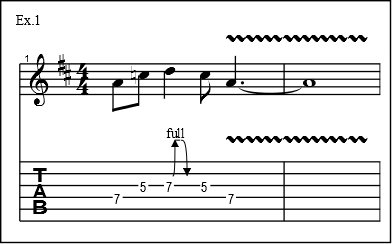
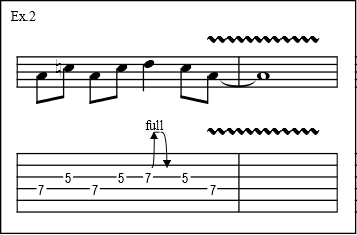

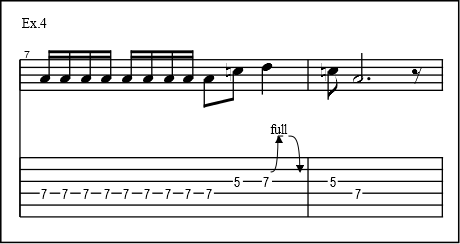
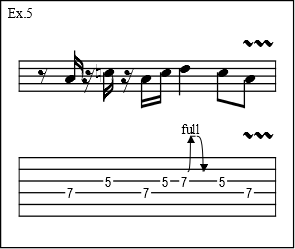
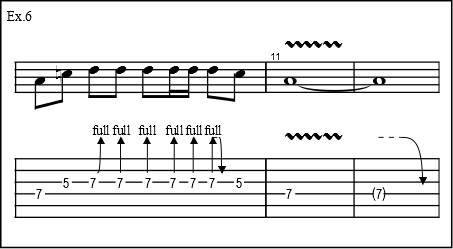
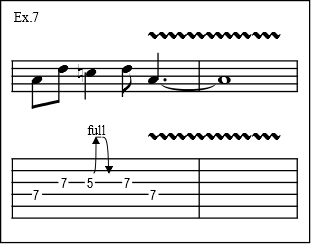
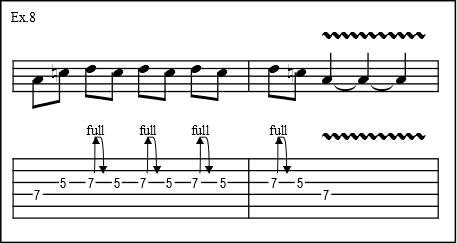
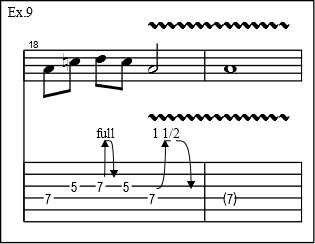


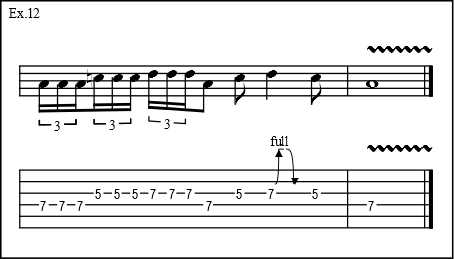
Hi, great job,
I have a question. at ex 11 you used a 6th fret(g#) on 4th string..it’s not part of A minor blues scale?
Thanks
Thanks Joao, no it is not part of A blues scale. It is in fact part of D blues, but don`t get too hung up on that.
I used the G# note as `passing note` to add some flavour to the lick. Notice it is played very briefly. You can play these passing notes (which are out of scale notes) at any point when jamming with these licks but you will have to decide which passing notes sound good (the note one fret below your `target note` is usually a good one). Just don`t hang around on that note for too long! Cheers
Great site, thanks so much for sharing
It is a pleasure, Robert. Many thanks for the comment. 🙂
Hi Dan, this is such a great idea and very helpful. I will really try to get those variations done. I have a question to example 6: I don’t know what the 7 in brackets (last note) means. Do I have to pre-bend the A to a C (7th fret on the D string) and then release the bend back to A? Andreas
Thanks, Andreas. The 7 in brackets means a tied note which is ringing out from the previous bar – no need to pluck this note.
Visit this blog to know about the maximum pentatonic power and how to use a guitar licks. I enjoyed reading this article. You would get the best review over here and would suggest others too. I like how you have researched and presented these exact points so clearly.
Thanks a lot for sharing this 🙌
[…] Go here to learn more about how to use the minor pentatonic scale. […]
Is there a way to translate those licks for a dummy like me who can’t read music or who doesn’t understand whether 5 refers to a fret or a string? I’d pay for that. For example, the first lick says it’s three noes–what strings and frets? I can learn any lick if I know the string numbers and fret numbers. I’m self- taught. No theory (it makes no sense to me).